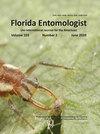贝宁草地贪夜蛾监测:评估诱捕器类型、信息素混合物和栖息地对信息素诱捕的影响
IF 1.2
4区 农林科学
Q3 ENTOMOLOGY
引用次数: 6
摘要
摘要秋粘虫草地贪夜蛾(J.E.Smith)(鳞翅目:夜蛾科)已成为全球关注的害虫。它最初被认为是西半球的地方病,在非洲首次被发现后,爆发了壮观的疫情,并蔓延到几乎所有撒哈拉以南国家。草地贪夜蛾对非洲玉米(Zea mays L.;Poacee)田地的快速入侵凸显了对大多数小农户综合虫害管理策略进行全面评估的迫切需要。然而,如果没有有效的监测和监督工作,这些战略就无法成功运作。这些诱捕研究旨在提供信息素-诱捕器-诱饵组合以及景观和农业实践的简单变化是否可以减轻秋季粘虫侵扰的指示。我们的数据显示,在测试的陷阱中,商用Unitrap是捕获秋粘虫最有效的设计。在秋季粘虫密度相对适中的第一个季节,这种廉价的自制2L罐子诱捕器能够持续收集秋季粘虫。然而,在所有条件下,自制诱捕器捕获的秋粘虫数量都比Unitrap低几倍,并且在秋粘虫密度较低的第二季中,自制2L诱捕器几乎没有捕获秋粘虫。在秋粘虫和捕获的非目标数量方面,观察到信息素混合物之间存在显著差异。4组分混合物在所有条件下都能吸引最多的秋季粘虫。双组分混合物是最具选择性的,在第二季实验中没有发现非目标物种。本文章由计算机程序翻译,如有差异,请以英文原文为准。
Monitoring Spodoptera frugiperda in Benin: assessing the influence of trap type, pheromone blends, and habitat on pheromone trapping
Abstract The fall armyworm, Spodoptera frugiperda (J. E. Smith) (Lepidoptera: Noctuidae), has now become a pest of global concern. Originally known to be endemic to the Western Hemisphere, its first detection in Africa was followed by spectacular outbreaks and spread to almost all sub-Saharan countries. The rapid incursion of S. frugiperda on maize (Zea mays L.; Poaceae) fields in Africa highlighted a crucial need for a comprehensive assessment of integrated pest management strategies in most smallholder farms. However, these strategies cannot successfully function without efficient monitoring and surveillance efforts. These trapping studies were designed to provide an indication as to whether pheromone trap-lure combinations and simple changes in landscape and agricultural practices might mitigate fall armyworm infestations. Our data show that the commercially available Unitrap was the most effective design for fall armyworm captures among the traps tested. The inexpensive home-made 2 L jar trap was capable of consistently collecting fall armyworm during the first season of relatively moderate fall armyworm density. However, the number of fall armyworm captured by home-made trap were several fold lower than by the Unitrap under all conditions, and almost no fall armyworm was captured during the second season by home-made 2 L jar when fall armyworm density was low. Substantial differences were observed among the pheromone blends with respect to numbers of fall armyworm and non-targets captured. The 4-component blend attracted the most fall armyworm under all conditions. The 2-component blend was the most selective, with no non-target species found during the second season experiments.
求助全文
通过发布文献求助,成功后即可免费获取论文全文。
去求助
来源期刊

Florida Entomologist
生物-昆虫学
CiteScore
2.10
自引率
7.10%
发文量
44
审稿时长
3 months
期刊介绍:
Florida Entomologist is the official journal of the Florida Entomological Society. Volumes 1-3 were published under the name The Florida Buggist. The Florida Entomological Society still produces the traditionally printed version of Florida Entomologist, but you can also view, search, or print any article published since June 1917 by accessing online files. Web access is made possible by the Society’s electronic publication project begun in 1993
 求助内容:
求助内容: 应助结果提醒方式:
应助结果提醒方式:


